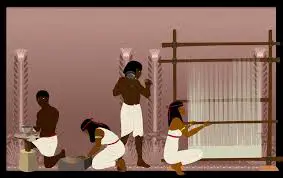Ancient Egypt is indebted to its artisans working day and night, with utmost talent, skill and hard work. They made Egypt what it is and what it is mostly known for in history. Although these unnamed Egyptian Artisans worked for rigorous hours under orders of a king or a noble, they really possessed an unimaginable amount of talent and expertise.

In the social hierarchy they were categorised between the Merchants and the Farmers, and they were hardly paid any attention to by the higher ranks. The maximum a King or Noble would do was throw a banquet for the highest artist, while many others toiled under the harsh Egyptian sun day and night, sometimes without food for days.
Supervisor of Egyptian Artisans
Among the artisans themselves too, there was a hierarchy, the head being the royal supervisor. There is evidence of a certain Pareneffer who worked under Akhenaten.
An artist would generally work in stone, clay, wood and fibre, bone, ivory etc. they also worked in metals like tin, copper, gold, bronze and iron. The clientele of these artists was the Royal Households, the Nobility and the ever growing bourgeoisie who could afford their services and products at varying degrees.
Crafts were generally learnt from the previous generations and it was more or less a family business. During Greco Roman times, traders acted as masters and hired apprentices too.
Some famous craftsmen’s names still survive. One hears of Imhotep, who worked during Zoser’s reign, and of Senmut, who worked under Queen Hatshepsut, Amenhotep, the chief architect of Amenhotep III, and Ineni, who designed the great Der-el-Bahri. But unfortunately, many others whose combined effort gave rise to these imposing immortal structures, remain anonymous for posterity.

Craftsmen were not allowed to sign their work because many people worked on the same project. The craftsmen were appreciated but not much respected. More than extolling their talent, the higher class extolled their own sympathetic and generous nature in displaying that they took grand care of the artists working under him.
Religion and faith in something higher than this world were the prime motivating factor driving arts and crafts in Ancient Egypt. Unfortunately, as is the case with all ancient art, religion also put constraints in the art form and thus, for centuries, Egypt’s art didn’t experiment or develop but rather remained constant.